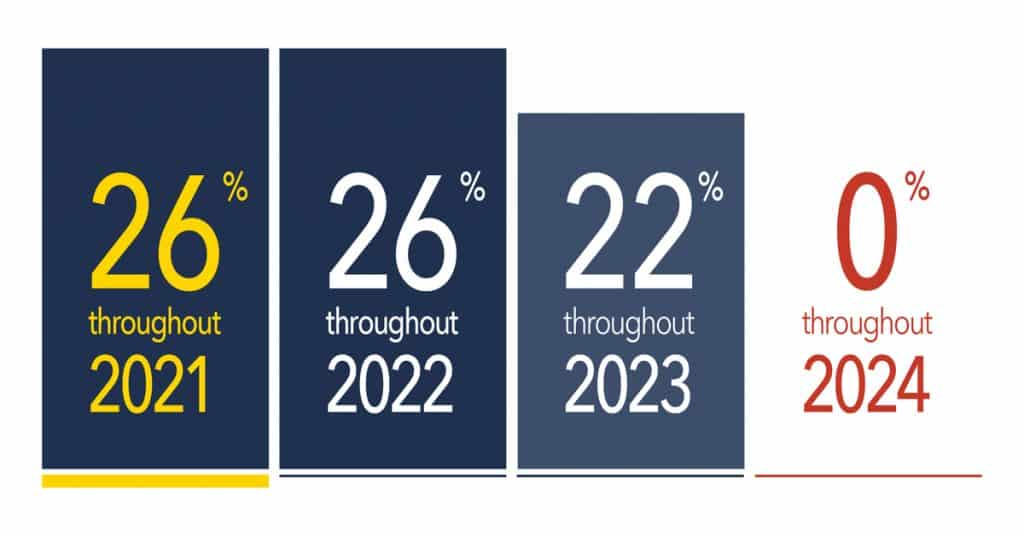Geothermal Investment Tax Credit Extended Through 2023

Great news – the Federal Investment Tax Credit (ITC) for geothermal has been extended through 2023! The ITC extension will allow homeowners who install a geothermal heat pump to deduct 26% of the cost of the system from their federal income taxes.
This extension is a huge incentive for homeowners who are looking to upgrade their heating and cooling system and greatly improves the return on investment for a geothermal system.
How Did it Get Passed?
On December 21st Congress passed an Omnibus spending bill, setting the federal government’s fiscal agenda for 2021. The Consolidated Appropriations Act outlines federal funds for specific projects, agencies, and programs for the upcoming year.
While COVID relief rightfully took the spotlight when former President Trump signed the act, there were important extensions for renewable energy tax credits. Most notably, an extension was passed for the ITC, which incentivizes homeowners to invest in renewable energy technology and make their homes more energy-efficient.
What is the Extension?

The extension of the ITC will cover 26% of the cost of a Dandelion geothermal system in 2021 and 2022. The percentage covered by the ITC will decrease to 22% in 2023 and 0% in 2024. The Geothermal Tax Credit covers expenses including labor, onsite preparation, assembly, equipment, and piping or wiring to connect a system to the home. Electrical upgrades may also be eligible.
The measure was previously set to drop to 22% in 2021 and expire in 2022 before the extension was finalized into law. Overall, the extension of the ITC is welcome news for proponents of renewable energy as well as homeowners looking to install geothermal heat pumps on their property in the near future.
Who Qualifies for the Credit?
The Consolidated Appropriations Act extends the ITC with all the same rules as it had before:
- Ground source heat pump equipment needs to meet Energy Star requirements at the time of installation
- The home must be located in the United States and be the residence of a taxpayer.
- It does not have to be your primary residence.
- You must own the property
- You can use the tax credit multiple times if you install geothermal in more than one home.
- The equipment must be new.
- The system cannot be used solely to heat hot tubs or pools.
- To claim the credit you have to pay enough in federal taxes. The ITC is a non-refundable personal tax credit that is applied to your tax liability to the IRS, so your tax credit cannot exceed the amount that you owe in taxes. However, if you don’t pay enough in taxes to recoup the full amount of the tax credit in the year you install, the remainder will apply to the next year and so on until you recoup the full amount.
There is no limit to the number of times or a maximum amount you can claim for the tax credit. If you have multiple projects that qualify for the credit, you can claim it for each of them.
For instance, Dandelion has several customers who installed geothermal in their primary and secondary homes and used the tax credit for both. The geothermal ITC can also be combined with solar tax credits or any applicable energy efficiency upgrade credits.
Who benefits from this tax credit?
Geothermal heating and cooling has traditionally been very expensive to install. In the past, this has presented a major challenge for homeowners who wanted to move away from fuel, propane, and natural gas.
Dandelion has worked extensively to drive down installation costs and make geothermal more accessible for homeowners. Dandelion’s drilling technology made installation faster and more efficient and offers financing options that are cheaper (as low as $140/month after incentives) than many homeowner’s monthly heating bills.
The extension of the Federal ITC, along with incentives available at the state level, have made Dandelion’s geothermal systems more affordable and cost-effective than ever.
How do you claim it?
Claiming the tax credit is about as simple as it gets for the IRS – you just fill out form 5695 when you file your taxes. Instructions to help guide you through the form can be found here. The IRS also has a commonly asked questions page for energy incentives, but neither has been updated to reflect the extension at the time of publishing.
It’s best to work with a tax professional who will know exactly how to fill out your new form for the tax break. This will ensure that everything is filled out accurately, and they can also help advise you on other potential energy tax credits you might be eligible for.
Homeowners will be happy to find out Dandelion offers an interest free bridge loan to cover the amount of the tax credit while you wait to receive it.
What Happens in 2024?
As it currently stands, the ITC will expire at the end of 2023. Renewable energy advocates will presumably lobby for an extension, but it’s too early to know what form that will take.
If you’ve been considering geothermal, now is the best time to take advantage of this tax break. With all the money you’ll save with the ITC, your payback period will be shorter and you will see a higher return on investment over the lifetime of your geothermal system.


